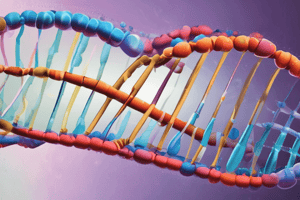Podcast
Questions and Answers
What type of DNA damage is specifically caused by UV radiation?
What type of DNA damage is specifically caused by UV radiation?
- Adenine adduct
- Guanine mutation
- Thymine dimer (correct)
- Cytosine dimer
Which process is NOT part of the basic stages of DNA repair?
Which process is NOT part of the basic stages of DNA repair?
- Recognition
- Recombination (correct)
- Replacement
- Removal
What can result from uncorrected alterations in DNA?
What can result from uncorrected alterations in DNA?
- Enhanced DNA replication
- Mutations leading to disease (correct)
- Increased protein synthesis
- Improved cellular function
Which of the following is a source of DNA adducts that can damage DNA?
Which of the following is a source of DNA adducts that can damage DNA?
Which enzyme is primarily responsible for reading the correct sequence from the complementary strand during DNA repair?
Which enzyme is primarily responsible for reading the correct sequence from the complementary strand during DNA repair?
What is the role of topoisomerase in DNA replication?
What is the role of topoisomerase in DNA replication?
What sequence best describes the process of DNA replication?
What sequence best describes the process of DNA replication?
In what direction do DNA strands grow during replication?
In what direction do DNA strands grow during replication?
Which enzyme is responsible for filling in gaps in the DNA during replication?
Which enzyme is responsible for filling in gaps in the DNA during replication?
What does semiconservative replication mean in DNA replication?
What does semiconservative replication mean in DNA replication?
How does gel electrophoresis separate DNA fragments?
How does gel electrophoresis separate DNA fragments?
What is the primary function of DNA sequencing?
What is the primary function of DNA sequencing?
What is a common error rate of DNA polymerase during replication?
What is a common error rate of DNA polymerase during replication?
What is the role of helicase in DNA replication?
What is the role of helicase in DNA replication?
What can cause errors during DNA replication?
What can cause errors during DNA replication?
Flashcards are hidden until you start studying
Study Notes
Key Enzymes in DNA Replication
- Topoisomerase: Uncoils the DNA to relieve the tension ahead of the replication fork.
- Primase: Synthesizes short RNA primers needed to initiate DNA synthesis.
- DNA Polymerase: Attaches complementary nucleotides in a 5' to 3' direction to form new DNA strands.
- DNA Ligase: Connects Okazaki fragments on the lagging strand, sealing gaps.
Importance of DNA
- DNA is universal in all living cells and is composed of nucleotides.
- Contains instructions for protein synthesis and carries genetic information inherited from parents.
Functions of DNA
- Acts as a storage medium for genetic information and as a blueprint for protein production.
- Undergoes replication during cell division to ensure continuity of genetic information.
- Genes encode for proteins through two main processes: transcription (DNA → RNA) and translation (RNA → protein).
Structure of DNA
- DNA has a double helix structure with two strands running antiparallel; one end is 5' (phosphate) and the other is 3' (hydroxyl).
- Base pairing occurs between adenine-thymine (A-T) and guanine-cytosine (G-C).
Sugar-Phosphate Backbone
- The DNA backbone consists of alternating sugar and phosphate groups with distinct ends: 5' (phosphate) and 3' (hydroxyl).
- New nucleotides are added exclusively to the 3' end during synthesis, maintaining the 5' to 3' growth direction.
DNA Replication Process
- Involves breaking hydrogen bonds between DNA strands, where each parent strand serves as a template for the formation of new strands.
- Results in a semi-conservative outcome where each new DNA molecule is comprised of one old and one new strand.
Semiconservative Replication
- Requires various enzymes, notably helicases for unzipping DNA strands and creating replication forks.
- Leading strand replication is continuous, while the lagging strand forms in short segments known as Okazaki fragments.
The Polymerase Chain Reaction (PCR)
- A laboratory technique for amplifying specific DNA fragments, utilizing cycles of denaturation and extension akin to natural DNA replication.
Gel Electrophoresis
- A method for analyzing DNA fragments by applying an electrical current through a gel, allowing separation based on size and charge. DNA moves toward positive electrodes due to its negative charge.
DNA Sequencing
- A procedure for determining the precise sequence of nucleotides in a DNA segment. Various sequencing technologies utilize fluorescent labeling for detection.
Errors in DNA Replication
- Mistakes can lead to mutations, potentially encoding defective proteins. The polymerase error rate is approximately 1 per 100,000 nucleotides.
- In humans, with roughly 6 billion base pairs, about 120,000 mistakes may occur during each replication process.
Factors Causing DNA Replication Errors
- Replication Stress: Includes unusual DNA structures and repetitive sequences that interfere with normal replication processes.
Causes of DNA Damage
- UV Radiation: Induces thymine dimers (T-T bonds).
- Chemical Exposure: Hydrocarbons from sources like coal, gasoline, burned meats, and certain drugs can cause DNA adducts.
DNA Repair Mechanisms
- Cells employ various repair strategies which generally include recognition of the error, removal, and replacement of defective sequences.
- DNA polymerase can also correct mistakes by reading the correct template strand.
Consequences of Unrepaired DNA Errors
- Uncorrected mutations can disrupt genetic instructions, potentially leading to diseases such as cancer.
Studying That Suits You
Use AI to generate personalized quizzes and flashcards to suit your learning preferences.




